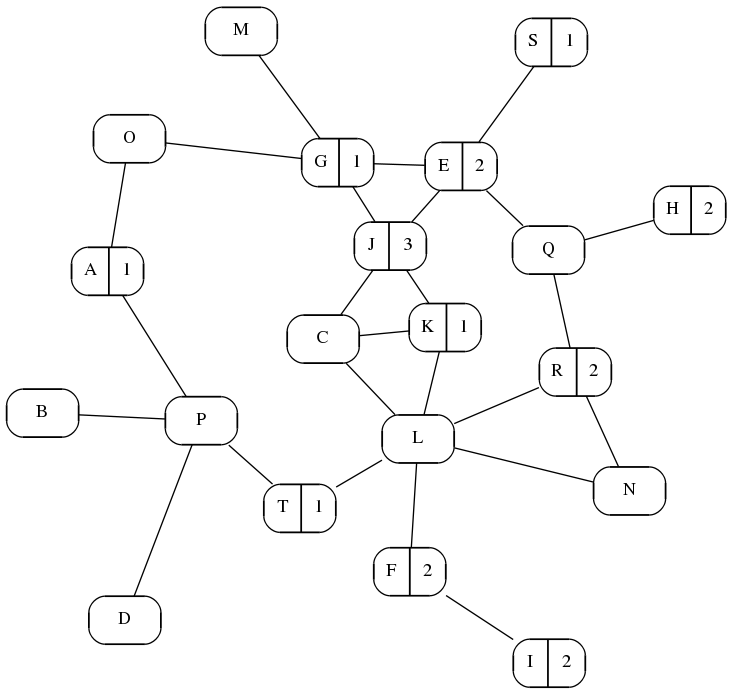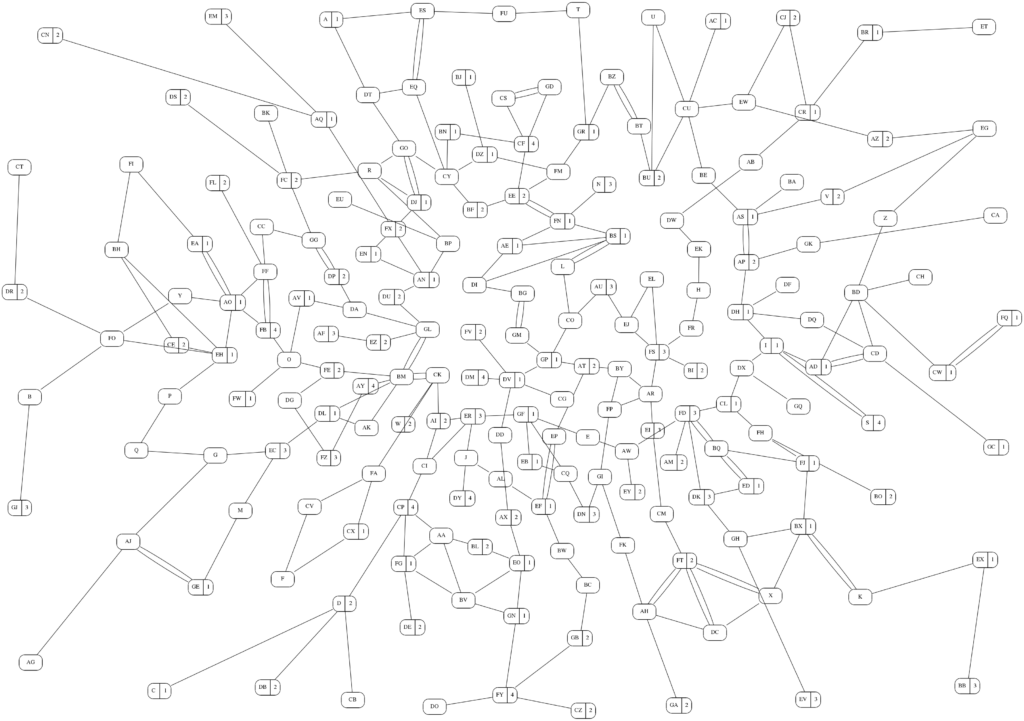When I published Polyhedral Pantheons in 2015 (… coming up on ten years ago, ow), it was based all on polyhedrons. First was the icosahedron (d20), prompted by the Rose of the Prophet series by Weis and Hickman, but extending the process to more polyhedra, and then making other adjustments (starting with adding faces to the sites).
I don’t remember if it was GreyKnight or if it was Barry Payne (Sycarion Diversions) who came up with it, but I feel it was likely one of them… what if we instead applied the process to a plane? Remove the constraint of a fixed number of nodes in a fixed arrangement, and open it up?
There are a few obvious consequences.
- No limit on how many deities. If I need more, I can add more nodes in a way that fits the graph.
- There is the possibility of removing deities. Strike a node so that deity is no longer present (this God of War is gone, but there are others).
- Might allow the neighboring deities to retain the domain, it’s just that one that is now gone.
- Potentially, allow one of the neighboring deities to fill the power vacuum — God of War is removed, one of the other war gods (i.e. deity with the War domain) shifts their interests and portfolio to take it over… leaving a different vacuum to be filled, or ignored).
- Can have multiple pantheons represented in the same graph, each having deities with different domain associations.
- Right now if I want multiple pantheons, they’re treated as completely dissociated with each other, unless I take steps.
- If the pantheons’ geographical arrangements are suggested by their placement in the graph, borderlands between the pantheons might draw from both neighboring pantheons.
Polyplanar Pantheon?
For instance, a plane of tessellated squares or hexagons would be simplest. Squares would mean each face and point would have a domain, and would represent a deity with five domains. With hexes the numbers are four domains per point and seven per face — I’d be tempted to not make ‘face deities’ at all in this case.
Polyplanarity Pantheons?
Somewhere around 2014 or so (I used it when I did the A-Z challenge in 2014), GreyKnight provided me a script that would generate planar graphs (that is, a graph that can be drawn with no crossing lines). The tool I use to render the images (neato) might in fact draw it with crossing lines because that makes a ‘least bad’ image, but it could be drawn without crossing lines.
Perhaps a picture would help.

This is a planar graph — a graph that is a planarity. Each node is identified by a letter (the number means something else not relevant here, but I might find a use for it).
I could assign a domain to each node, and each node represents a deity with that domain and the domain of the neighboring nodes. For instance, ‘Deity J’ would have the domains from nodes (J, G, E, C, K), Deity Q would have the domains for nodes (Q, H, E, R), and deities I and J have only two domains each — (I, F) and (D, P) respectively.
I’m not sure yet how I feel about this, but… let’s check the frequencies. In this 20-node graph, I see nodes with the follow domain counts:
- 2: B, D, F, H, I, M, S
- 3: A, N, O, T
- 4: C, K, Q, R
- 5: E, G, J, P
- 6: —
- 7: L
This is a little all over the place, but… I don’t hate it. Seven domains is a lot for a deity, two domains are functionally a minimum (and indeed, in a connected graph, the actual minimum), but having a range of domain frequencies intrigues me.
Even Bigger
GreyKnight’s script can have a basically arbitrary number of nodes. I have run it up to 200 nodes, shown below.

This one shares many characteristics with the smaller graph. We see intersecting lines with this one because with this many nodes, the layout engine found this to be the ‘least bad’ layout. It is possible to rearrange the graph to make a planarity (linked puzzle game is kind of fun, if you’re like me) but the script only generates something that can be laid out as a planarity, the layout engine doesn’t necessarily do so.
Something else present in this graph that is not in the simpler graph is having multiple edges between nodes, such as between AJ and GE near the southwest corner. In adventure design this represents nodes with multiple direct connections (such as a two rooms that open onto the same hallway but share a door directly between them.
I’m not doing a frequency analysis on this one (not modifying the script and not counting them by hand), but I don’t see anything egregiously overconnected. DV, BD, and FS each have six domains, BM has seven… nothing really jumps out as having more.
… either planarity graphs like this just take a lot more explaining than a regular grid, or I really like how this fits together. I’m leaning toward “I really like this”.
Closing Comments
This post approaches ‘off-topic’, but I’m ruling that a variation on Polyhedral Pantheons is fair game for this blog series.
Later, though… I think this post shows me how to solve another problem I’ve been facing. I worked on 13th-Age Icons in the Sandbox in 2016, and one of the problems I struggled with was how the icons I created in that series were really relevant in only the area — basically an island, if a somewhat large one — and I didn’t see a way to reasonably extend beyond that.
I think I see now how to do that, but that will take me farther off-topic. I will write a post on it, but I’ll either wait until after this year’s A-Z Challenge is complete (only a few more days! I can wait!) or write two posts for tomorrow.
Let’s see what tomorrow brings.

